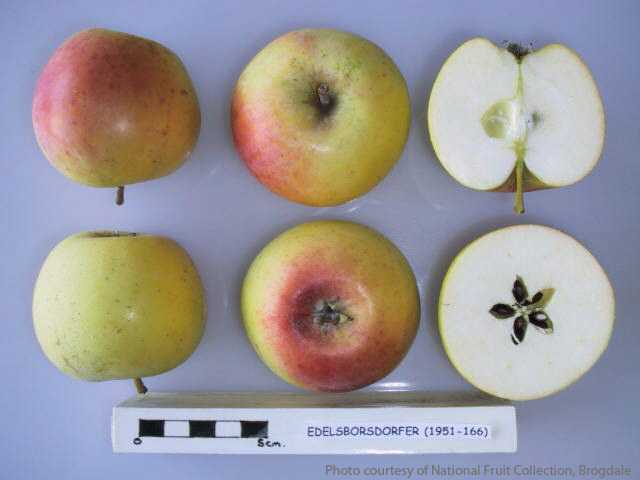Pomiferous
Welcome to the world's most extensive apples (pommes) database.
Information on over 7,000 apples is available here, all carefully researched and provided in a way that is easy to navigate.
Borsdorfer

type: Culinary, Dessert, Pollinization
synonyms: As is typical for an apple which has been on hand for as long as the Borsdorfer, this popular European variety goes by a long list of of names including Borsdorf, Borstorfer, Bursdoff, Edelborsdorfer, Edler Winterborsdorfer, Herbstborsdorfer, Borsdorfer Queen Apple (sometimes Queen Crab) and Borsdofer Queen Renette, Reinette Batarde, Reinette d'Allemagne, Leipziger Crab), Rubinaapfel, Schwarzer Borsdorfer, Maschantzger, Marschansker, Zigeunerapfel, Garret Pippin, King, King George, King George the Third. It is, however, not the same apple as the RF: Breunsdorfer .
Note that there are several apple varieties known by variations of the Borsdorfer name: Borsdorfer ,( Angelner Borsdorfer ), Roter Münsterländer Borsdorfer , Thurgauer Borsdorfer , Borsdorfer Herbstrenette and Gelber Münsterländer Borsdorfer .
summary: A popular fresh-eating apple in Western Europe since the Middle Ages.
identification: Small tending to medium, round-flattened. The skin is glossy with a waxy, pale yellow base colour, over which is a faded red wash on the sun-exposed face and liberally dotted with yellow lenticels. The shaded face is brownish with wisps of yellowish grey russetting extending over the shoulder. The calyx is small to medium size, partly open and set in a shallow, pleated basin. The stem is very long and slender, set in a narrow and deep cavity which is typically russetted.
characteristics: The flesh is white, crisp, juicy and sweet and hints of cinnamon.
uses: German horticulturist Johannes Wittichius ventured in "Methodus tum simplicium tum compositorum medicamentorum" (published in the late 1500s) that the Borsdorfer apple can be used to treat epidemic fevers and even madness.
origins: It was first mentioned by Valerius Cordus, a German physician and botanist, in his "Historia Stirpium et Sylva" published posthumously in 1561, identifying it as a German variety from the village of Borsdorf in Saxony. During the mid 1800s, it was, for a short time, listed among the 10 most recommended apples. However, its popularity waned quickly thereafter, in large part because of its tendency to take a long time before bearing fruit.
cultivation: Vigorous, upright spreading tree. Very hardy. Slow to bear fruit, but when it does it produces good harvests on an annual basis with a slight tendency to become biennial. Seems to grow best in clay soils. On its own roots, this variety tends to grow very large and very old.
cold storage: Keeps two to three months after which time it loses its fine aromas.
harvest: Ready for harvest in midseason and used over the course of three months.
notes: This apple is frequently confused with the RF: Breunsdorfer . The white-fleshed Borsdorfer originated at Meissen (Germany), some 120 kilometres east of Breunsdorf (Germany) where the red-fleshed Breunsdorfer comes from.
Note that there are several apple varieties known by variations of the Borsdorfer name: Borsdorfer , ( Angelner Borsdorfer ), Roter Münsterländer Borsdorfer , Thurgauer Borsdorfer , Borsdorfer Herbstrenette and Gelber Münsterländer Borsdorfer .
pollination group: D
pollination peak: 14
ploidism: Diploid. Self sterile.
cold storage weeks: 12
harvest period: 5
Donate a cider?
©2016-2021 Pomiferous.com. All rights reserved